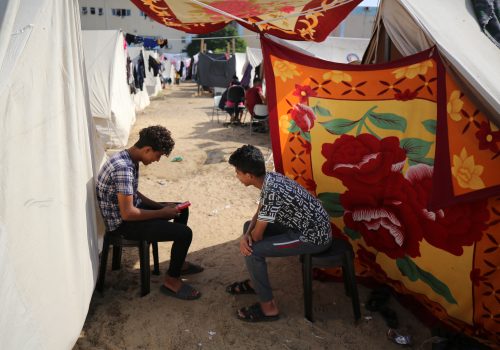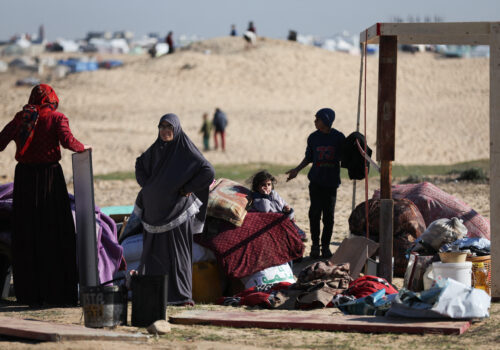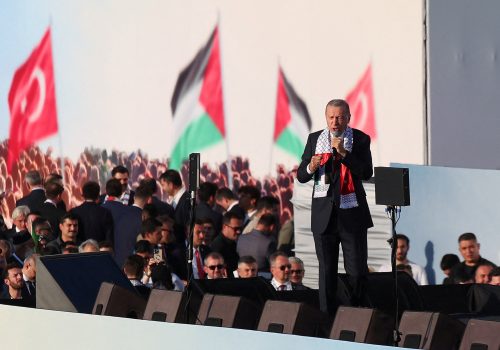Can whatever remains of Hamas in Gaza be administratively and politically rehabilitated?
Over four months after Hamas’ horrendous October 7, 2023 attack on Israel, the Israeli military is nowhere near the decisive victory that it sought against the Islamist group.
Evidence does suggest that Hamas has lost significant capabilities to sustain its armed resistance. The rockets being launched toward Israeli cities and targets have gone down significantly, and there are only small pockets of resistance in the northern Gaza Strip, where some rockets are still being launched. Estimates point to the remainder of Hamas’ forces being largely present in southern Gaza, particularly in Khan Younis and Rafah.
Nevertheless, almost daily, the group publishes videos of its fighters launching anti-tank projectiles at Israeli armor units and troops and documenting various attacks, resulting in Israeli casualties, including twenty-one Israeli soldiers on January 23. Most importantly, Hamas retains a significant number of its tunnels, including strategic ones that double up as shelter facilities and operational sustainment centers, even though the Israel Defense Force (IDF) has revealed the destruction of many of them. New Israeli estimates based on uncovered evidence point to the presence of up to 450 miles of tunnels under Gaza, far more than initially believed. The failure to retrieve the remaining Israeli hostages is further evidence that Hamas still has robust hidden networks and combat-effective cells.
As the humanitarian conditions throughout Gaza become catastrophic for the coastal enclave’s civilian population—particularly right now, given the seemingly inevitable onset of famine—growing diplomatic and political pressure on the Israeli government may force a significant change to the scope and objectives of the operation. The maximalist goals that Israeli officials stated at the beginning of the campaign may very well have to be tamed and reduced to more modestly achievable outcomes that do not bring about the total destruction of Hamas.
Most day-after models, scenarios, and plans for Gaza’s future have assumed the IDF’s ability to break and destroy the Islamist group entirely. Few have contemplated an end to the war that sees some of Hamas’ military and governance capabilities remaining in place. While Israeli planners have spoken of subsequent phases of the military operation that will go on for many more months, they represent low-intensity efforts that will likely be focused on the most serious of militant threats—not the eradication of every single Hamas member and government employee.
This poses an uncomfortable and pressing question: What do Israeli, US, Arab, and international decision-makers do with a devastated Gaza Strip, where militant infrastructure has been severely weakened but is still under some control by Hamas’ remaining presence?
There are three gradual and linked phases that may help in navigating such a scenario.
The first phase requires a negotiated settlement that includes the release of the hostages as part of a prisoner swap mediated by Qatar and Egypt; the initiation of a long-term ceasefire; and the beginning of a gradual transformation of Gaza’s political system. Most importantly, this would require options for senior Hamas leaders and members to depart Gaza under international guarantees, similar to the Yasser Arafat and Palestine Liberation Organization (PLO) departure from Lebanon after the 1982 Siege of Beirut. What becomes of these individuals once they depart Gaza is between their host and Israel’s priorities. The main concern of this phase would be ending the presence of Hamas’ military leadership through political means. Given that almost none of the group’s political leaders are currently in Gaza, this would effectively leave Hamas’ remaining rank-and-file without any motivation to act on behalf of a leaderless organization.
SIGN UP FOR THE THIS WEEK IN THE MIDEAST NEWSLETTER
The second phase requires establishing an interim provisional administration that would initially recycle most existing governance bodies responsible for administrative functions throughout Gaza’s various sectors. A mix of Palestinian Authority (PA)-paid employees—including those in the finance and water management sectors, along with Gaza government-employed teachers, doctors, and public safety officers—could quickly bring about some resemblance of a functioning administration. This phase is arguably the most crucial because it will necessitate retaining some of the public safety infrastructure in Gaza, and will help fight crime, chaos, and the disruption of humanitarian aid distribution. The provisional use of existing public safety employees is critical for rapidly facilitating the removal of rubble and unexploded munitions, as well as the establishment of a temporary port to receive aid and power-generating ships. This measure would also enable the formation of a new administrative body that can set up a capable and professional police force with Palestinian, Arab, and international involvement and support.
It is important to note that regardless of what a revitalized Palestinian Authority looks like and whether that conforms to the publicly stated expectations of the United States and international community, the weak, yet still functioning and existing PA frameworks, are sufficient for kickstarting a new reality in Gaza after the cessation of the IDF’s operation. This primarily entails representing Gaza’s interests in international arenas to ensure that Palestinians have a voice in all planning discussions. The PA will be vital in giving political and diplomatic legitimacy to post-war efforts aimed at aid provision, reconstruction, political reform, restoring public services and administrative functions, managing various financial transactions (e.g. paying worker salaries), and, more importantly, creating a new internal and outwardly facing security infrastructure. The situation in Gaza cannot afford to wait for a completely revitalized PA to emerge per US expectations; instead, working with what is present will, in fact, begin the path of rejuvenation that is needed for the desired effectiveness of the PA.
The limited presence of the PA in the Gaza Strip, by definition, means that its role in the coastal enclave will require new structures, systems, and processes, not just the importation of West Bank apparatuses or the activation of dormant Gaza staff and administrative structures. The success of the PA’s role will depend upon its ability to use intelligent and level-headed messaging and professionals to build foundations for a new, prosperous, and terror-free Gaza. It was the PA’s incompetence and corruption—real or perceived—that contributed to Hamas’ political and electoral rise in the first place. For the PA to play a meaningful role in reshaping Gaza’s future, it must learn from past mistakes to gain legitimacy with its battered, resentful, and traumatized population.
The third and most challenging phase calls for initiating the reconstruction effort along a parallel track to transform Gaza’s political system. The reintroduction of some elements of the Palestinian Authority, along with Arab and international monitors, would signal that a new political process is beginning to take shape. During this phase, existing day-after scenarios that have already been articulated for Gaza may have a chance at implementation. Additionally, at this stage, broader regional reorientations, particularly between Saudi Arabia and Israel, may provide a catalyst for reinvigorating the two-state solution and pragmatic steps toward implementing it.
Primary considerations should focus on the gradual pace of change amidst unprecedented destruction while ensuring that Gaza’s borders with Israel are secured and a repeat of October 7, 2023 can never take place. With its ground and surveillance assets, the IDF is more than capable of securing the border from the Israeli side and detecting militant threats.
The most troublesome open-ended question is what remains of thousands of Qassam Brigades fighters who will still have some of their weapons and military training? Can these fighters be rehabilitated, de-radicalized, and recycled into a new Gaza administration? Can contemporary examples, such as what happened with Columbia’s Revolutionary Armed Forces (FARC) rebels, the Irish Republican Army members in Northern Ireland, or the PLO fighters (who became the nucleus of the Palestinian Authority), serve as viable examples for political rehabilitation? If Hamas members who were not involved in egregious crimes against Israelis are willing to be part of a new administration, would Israel and the US support a rehabilitation program?
A combination of incentives, safety guarantees, and promising prospects could provide viable off-ramps for leaderless and commander-less Hamas fighters looking for a way out of a quagmire. Despite their ideological orientation, members of the Qassam Brigades are, in essence, employees of an organized outfit with monthly salaries, benefits, and incentives that reward their dangerous and deadly work. While a certain segment of these fighters are irredeemably radical and militant, serious thought should be given to programs, initiatives, and offers that could provide a safe and dignified way out for thousands of young Gaza men whose conditioning, circumstances, and sociopolitical resentments led them down the militancy path.
Creative approaches, such as weapons buy-back programs—especially those seeking to collect strategic gear like anti-aircraft missiles, long-range rocket systems, weapons manufacturing machinery and equipment, mines, rocket-propelled grenade launchers, and heavy munitions—could prove vital in shrinking the availability of weapons inside Gaza. This, coupled with continuous monitoring to prevent future smuggling, will reduce the ability of remaining Hamas fighters to sustain a post-war insurgency, particularly if most of their leaders are exiled or eliminated.
Another approach worthy of consideration is the successful experiment with the Awakening Councils in Iraq (also known as the Sons of Iraq), which sought to combat the atrocities of al-Qaeda during the height of the Iraqi insurgency. Sunni tribal leaders, former Iraqi military officers, and even former insurgents and militants were rehabilitated in a new security architecture to leverage their expertise and local know-how to combat ruthless insurgents. This approach proved invaluable in taming widespread violence in the Anbar province and the “Sunni Triangle,” ultimately supporting the success of General David Petraeus’ “surge” in stabilizing Iraq at that time. However, the success of the Awakening Councils was reversed due to the refusal of the Shia-dominated Iraqi government to integrate Sunni fighters into the Iraqi security forces, setting the stage for many of these Councils’ fighters to join the Islamic State of Iraq and al-Sham (ISIS) years later. Similarly, many Hamas fighters may abandon militancy if they are offered a long-term and sustainable path into a new system that incentivizes them to abandon violence or be part of a new security paradigm.
The disastrous de-Ba’athification program following the 2003 US invasion of Iraq is a cautionary tale of a zero-sum approach to reconstruction and political rehabilitation. While the policy may have been well-intentioned in wanting to root out remnants of Saddam Hussein’s regime from the new Iraqi political system, it contributed to the ensuing chaos and an insurgency by resentful public service workers without prospects in the new country. This is important to consider because there are many public service employees working under Hamas’ regime simply because it is the only employer in town. These employees, including those in the healthcare, education, and public safety systems, could prove vital if retained in a provisional administration to run Gaza’s affairs.
Destruction is easy, but building is hard. After Hamas’ criminality and horrendous conduct toward Israelis and even its own people, it might be tough to tolerate a scenario in which some of Hamas’ infrastructure is recycled into a future Palestinian political system. However, the realities on the ground and Israel’s inability to fully eradicate Hamas, coupled with a catastrophic humanitarian situation that will likely accelerate the end of the war, necessitate these uncomfortable discussions. Undoing decades of Hamas’ terror and administrative control will require convincing Palestinians to turn away from the Islamist group’s ideological and political subjugation of Gaza. Indeed, contemporary history has multiple examples of political actors and players who were involved in violent terror before getting rehabilitated as part of agreements and processes. What remains of Hamas in Gaza may be no different.
Ahmed Fouad Alkhatib is a naturalized American citizen from Gaza City and provides analysis and opinions on the Gaza Strip’s affairs and politics. Follow him on X: @afalkhatib.
Further reading
Fri, Oct 27, 2023
A humanitarian corridor in the Israeli Negev could save Gazans
MENASource By
There is no perfect solution to alleviate the death and destruction that awaits in the Gaza Strip, but getting women, children, and the elderly out of harm’s way would be a positive step.
Wed, Jan 10, 2024
Egypt was mediating a deal to end the Gaza war. Then Saleh Al-Arouri was assassinated.
MENASource By Shahira Amin
Keen on regaining its traditional leadership role as chief mediator between Israel and the Palestinians, Cairo had put forward a three-stage plan to end the conflict.
Mon, Oct 30, 2023
Erdogan leans on Israel, pushes for post-war role in Gaza
MENASource By Rich Outzen
The Turkish president's ultimate goal is to be present and influential in the post-war settlement regarding Gaza and to be a key player in the mediation and reconstruction process.
Image: Palestinians fleeing Khan Younis, due to the Israeli ground operation, amid the ongoing conflict between Israel and the Palestinian Islamist group Hamas, move towards Rafah, in the southern Gaza Strip, January 25, 2024. REUTERS/Ibraheem Abu Mustafa


